In order to collect and address the various arguments of this debate and make them accessible to a wide audience, 40 master’s students from two different departments – Social Sciences (Historical and Cultural Anthropology) and Computer Science (Machine Learning) – collaborated on a project. Over more than a year, and together with their lecturers (Prof. Thomas Thiemeyer, Prof. Ulrike von Luxburg, Tim Schaffarczik) and a team from the Stadtmuseum (Guido Szymanska, Wiebke Ratzeburg), they developed an exhibition for the Stadtmuseum Tübingen titled: “Cyber and the City: Artificial Intelligence Moves Tübingen”. It presents the background and developments of machine learning and AI in Tübingen and gives the public a basic understanding of important concepts.
We spoke to three of the students about the exhibition project: Mara Seyfert and Julian Petruck are studying for a master’s degree in Machine Learning, and Hanna Scheffold is in the Historical and Cultural Anthropology programme.
What motivated you to take part in this exhibition?
Mara: It immediately aroused my interest, because I already discuss AI a lot with the people around me and I’m simply very interested in the topic. There’s a great need to educate people about it, but also many concerns. In addition, everything I learn and create in my classes usually remains virtual or on some server. So, I wanted to take what I’m capable of and what we deal with in our courses and turn it into something that other people can experience. And to develop something tangible out of it that people can touch and try out.
Julian: In the past I’d often tried to do interdisciplinary projects in my courses and it was always fun. It was also always really productive, so that’s why I thought that would be a really cool thing to do. Later, I realised that if you have a topic that’s really so current, you can also achieve a lot with it. Organising an exhibition like this has reached a lot of people.
Hanna: In our Historical and Cultural Anthropology programme, this study project is one of the required courses. I focus on diversity, and in the beginning, I only knew about AI based on media reports, which usually highlight concerns about the future. I didn’t really have an idea what AI actually was. What appealed to me more was that we were putting on an exhibition. I’d never done that before. And the creative aspect was really the nicest part for me. Besides that, I learned that I also have to deal with topics that I personally wouldn’t do on my own, because I only realized the true benefits after we were finished. Since then, I have really reduced my fear of the unknown, so this interdisciplinary work has been a really great experience.
What does a joint collaboration look like and what are the challenges?
Hanna: One challenge was this vacillation between ‘How much responsibility do I have?’ and how much say do I have. If someone had an idea, it wasn’t immediately thrown into the trash can, and at the same time we had to allow it to develop a life of its own within the group, so that in the end, something entirely different comes out of it. That was always difficult. [To Julian] For example, I was in your group, and I was watching from the outside. At the beginning I thought, ‘Oh my God, I don’t even understand this.’ And then afterwards I trusted that you guys knew exactly what you were doing, and also used our feedback.
Julian: At the beginning we talked a lot about it and brought in our ideas of what the exhibition could look like. But regardless of the detailed work you put in on your own contribution, you had to realise that you had no influence on the entire exhibition. I sometimes thought: ‘Why is it being done this way? I don’t follow the reasoning.’ And then to trust that in the end, all will be o.k. It wasn’t that easy sometimes, but ultimately it worked out well.
Mara: To some extent, we were also required to have skills that don’t necessarily have that much to do with machine learning. For instance, programming the interface of an app isn’t covered in my courses. But then we had someone in our group who already had experience with it and could help the others. Much of the process involved answering the question, ‘Who has what skills and how can we throw them all together to get something out of it that works?’
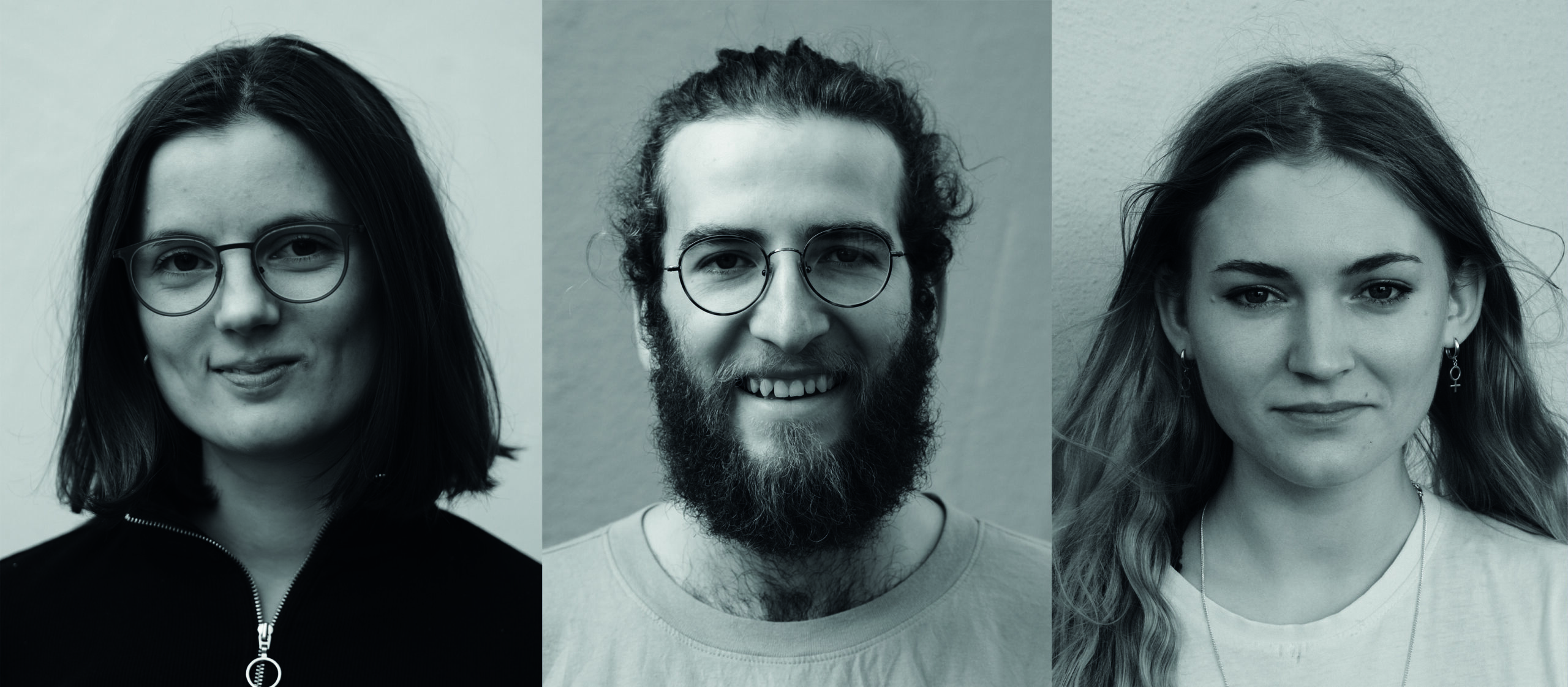
The three students Mara Seyfert, Julian Petruck and Hanna Scheffold. © FRANZISKA-SOPHIE WALTER
Normally you write a seminar paper or an exam after the seminar and it ends up in your student records or with the seminar leader. This time the result is an exhibition in a public space. What did you have to pay particular attention to and what are your thoughts on this?
Julian: For us in the group, the biggest challenge was the message we wanted to convey. Getting everything across in just one exhibit, which needed to be both brief and concise while at the same time somehow hold people’s attention. We were always being told, ‘No one is going to spend more than three minutes at your station.’ The message had to get across in those three minutes. When we started, we wanted to cram in a ton of information, because we thought it was super-important to show all sides of the issue. That’s important too, and we’ve always worked that in somehow. But it was a huge challenge to manage it and still have something brief and to the point.
Mara: Yes, for me one big difference was that the topic had to be understandable for people who otherwise haven’t had much exposure to it. So we put an incredible amount of thought into comprehensibility. But it was also important for the thing to be fully tested by opening day. It can’t crash if you press a wrong button, there can’t be any surprises. At the end of the day, everyone was actually surprised at how much time went into getting everything really in shape for the exhibition.
Julian: And in terms of working with the museum, it was sometimes difficult to find an agreement because they were operating under different requirements. For example, we didn’t code much for the exhibit in my group – there is no machine learning system behind it. The difficulty was in developing a story for our project. And then there was this moment when the museum felt that our message wasn’t getting across. But because this content was important to us, we were so convinced of our concept and our approach and we wanted to communicate it. It was really tough to find common ground. But interestingly, I think that exactly because it was such a difficult and lengthy process, it really made our exhibit much better. I think without that process and without that friction, it wouldn’t have turned out as well as it did, even if it was exhausting at the time.
Can you go into more detail about this exhibit and shed some light on the difficulties?
Julian: We chose a dystopian scenario: facial recognition was to be used at the door of the student clubhouse in Tübingen to identify students. But the system isn’t working quite yet, and the visitors are supposed to help train it so that it can recognise students. To do this, they are asked to independently select a number of data sets that best represent this group. As they’re doing so, their attention is drawn to the fact that they should select a data set that is as balanced as possible, because the student body is very diverse. Every possible demographic group needs to be recognizable. And then they realize that the selection process is not that easy, because there are also factors that are less typically discriminatory in nature. For example, if people who wear glasses are not in the data set, the algorithm will have a problem recognising people with glasses. That’s something that might not necessarily occur to you, but it’s something you need to be aware of when you’re collecting data and creating a data set. That’s the point we wanted to make, but also that these kinds of algorithms are not well suited for such purposes and therefore shouldn’t be used.
Hanna, how did things go with your exhibit and your focus on diversity? Do you have the feeling that your concept of diversity is actually well represented there?
Hanna: At the beginning, I was really worried because, for example, we didn’t have any Black students in our photo data set and then the question came up of how can we then make an exhibit that presents diversity as something worth protecting? And what if our exhibit ends up being discriminatory? We obviously didn’t want that at all. What we wanted to show is that, unfortunately, AI does discriminate, and it’s not easy to train it properly, because there are also biases that you don’t even see. [To Julian] In the end, when I finally understood that you guys had totally taken this into account, I was so enthusiastic about the exhibit. And in retrospect I realise how well the message works: by using this example, the danger can be shown to people better than if you have the algorithm tell the difference between a spruce and a fir tree. There were a lot of worries at the beginning, but through the process I came to understand what bias is, and how little the programmers should be blamed when they consider all kinds of these sorts of issues and bias still manages to slip in. That’s when I slowly started to understand the social side of the debate and lost my fear of the machine that will destroy us all.
What do you think the contribution of this exhibition is?
Hanna: I think people have a great need to speak and to be asked, and also to get answers to questions that they don’t dare to ask. Our feedback board at the end of the exhibition, for example, is good for this. And to generally learn more about the ‘Who? How? What? Where? When?’ of the topic. I find the ‘who’ in particular quite exciting, that there are faces. In each room there is a video where someone talks about how he or she experienced the Cyber Valley initiative and the protests. I also think it’s really good that scientists like Ulrike Luxburg had the opportunity to reiterate and to see how outraged the masses suddenly were – how difficult it is then to really enter into dialogue when people have become entrenched in their attitudes.
Mara: In the tours that I’ve given, I’ve noticed a difference based on age: the younger people are interested in technology and try out a lot of things, while the adults are more sceptical about AI itself. They’ve already read about AI and are asking themselves questions like: ‘What effect will AI have on my job? Who actually appoints this ethics advisory board and controls it?’ They ask many questions, and think it’s positive that criticism of AI receives so much coverage in the exhibition. And the younger ones say: ‘Wow, the exhibit is cool, because it doesn’t just present AI in a positive light, it also deals critically with the topic. And some things were not so clear to us and now we’ve learned about them.’
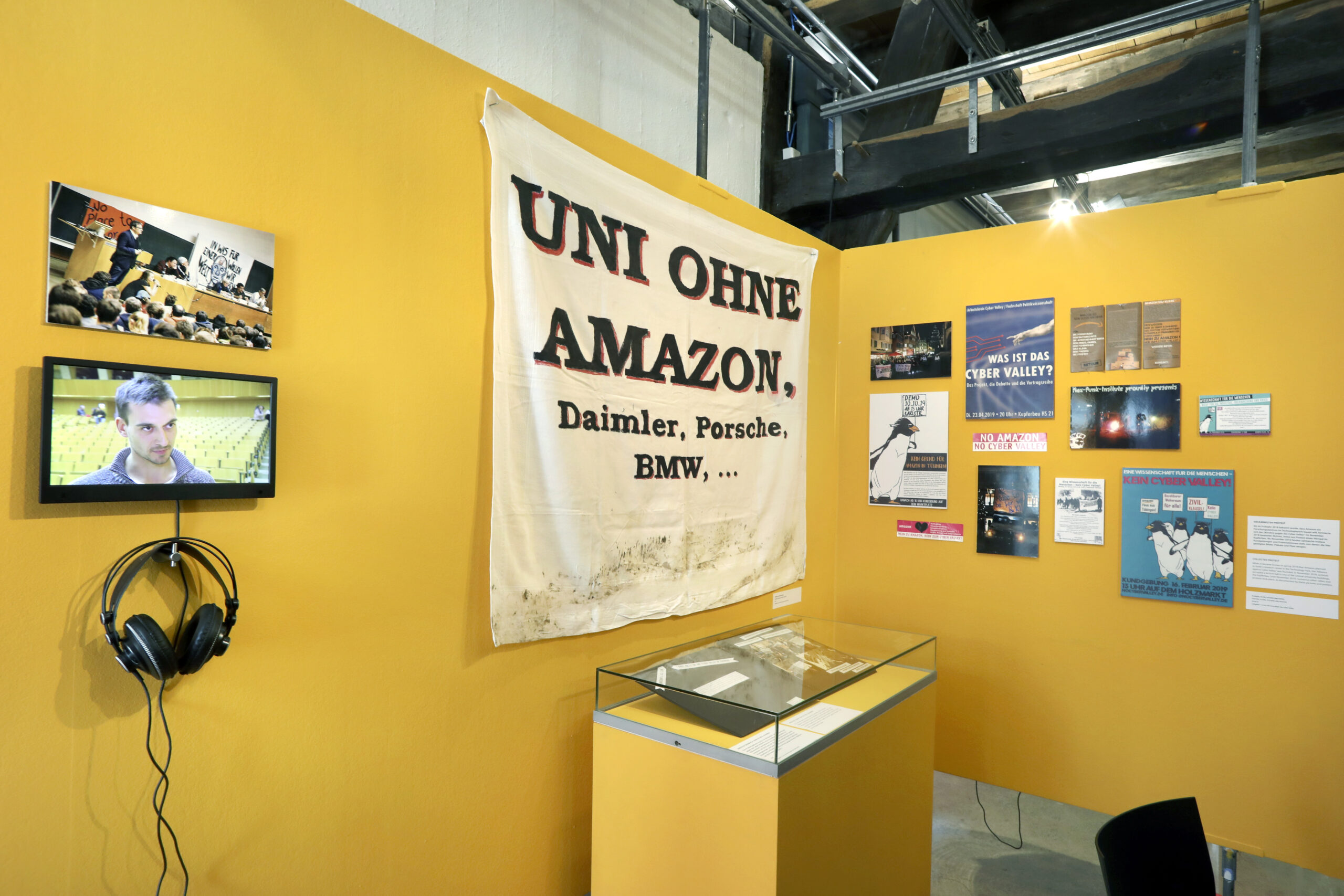
Critical voices and protest actions about AI in Tübingen also found a place in the exhibition. © ANNE FADEN / TÜBINGEN CITY MUSEUM
And would you take part in an exhibition project again?
Mara: Yes, because on the one hand it appeals to me to work in an interdisciplinary way, and on the other hand I like having so much freedom to implement my own ideas. But I would schedule more time, because it was really a lot of work towards the end.
Hanna: I would also take part again. It is so important to work in an interdisciplinary way, especially at university. I think that happens far too little. And you have a lot of opportunities: I was able to get access to offices where I wouldn’t have been allowed to go otherwise. I could just walk into the Max Planck Institute and then have this exchange with the machine learning students. Before that, I imagined the machine learning curriculum to be completely different.
Julian: The response has shown me that it’s really important to do exhibitions like this. It was lots of fun. And no matter what you do, at some point there is always a phase that’s exhausting. But at the end it’s really rewarding. And you could let your creativity run free, which I often don’t get enough of during my studies. And that’s why I would gladly do it again.
Interview: Tilman Gocht, Aikaterini Filippidou
Header image: © Anne Faden / Stadtmuseum Tübingen
NEWS
Due to the great interest the exhibition will be extended until January 21, 2023. Additionally the Cluster of Excellence will be presenting the interactive art exhibit IN-ML-OUT from November 16, 2023 in the Stadtmuseum. The exhibit demonstrates how machine learning helps in making wind power more efficient.
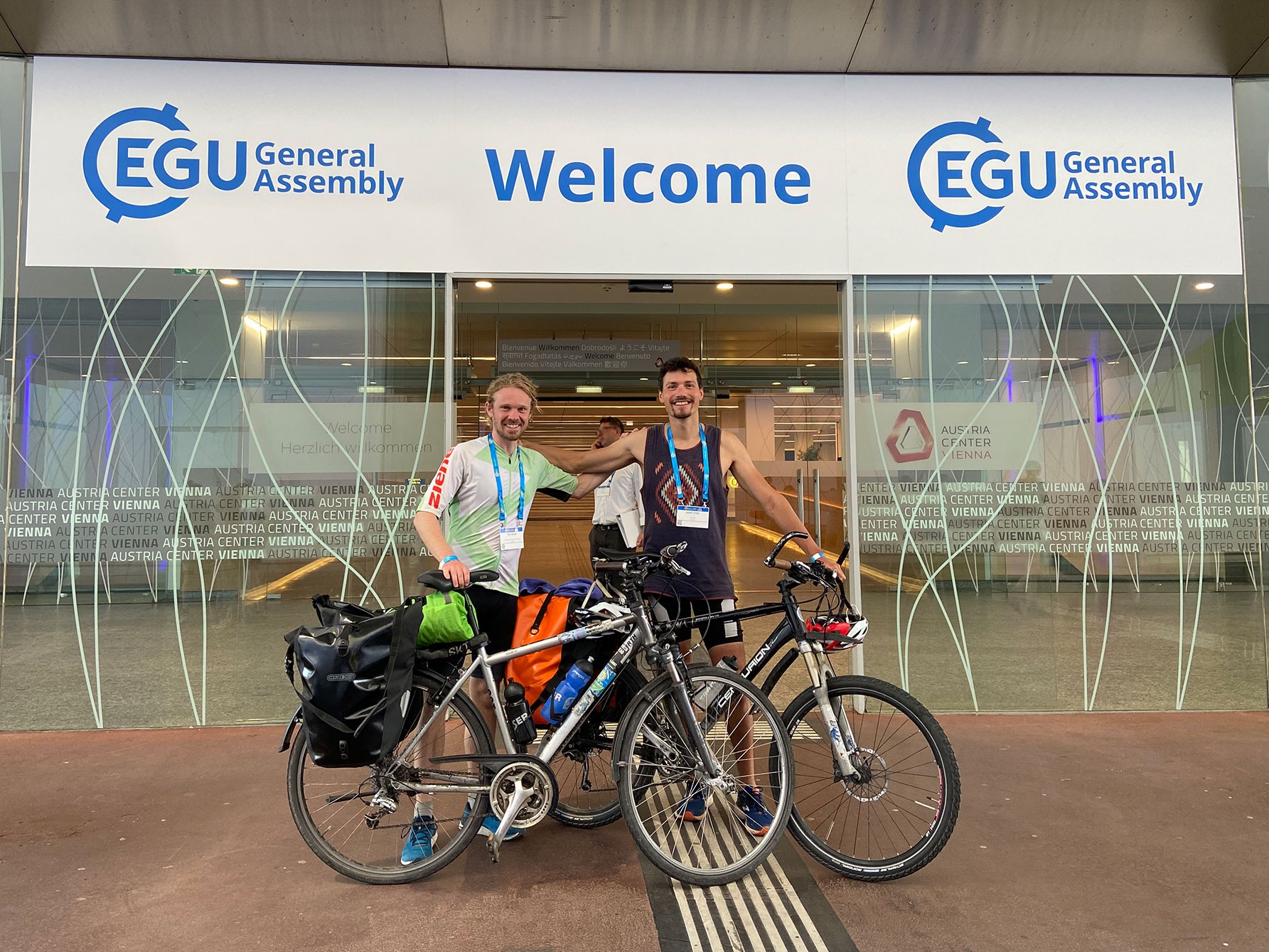
How to make business trips more climate friendly

New Directions in Science Communication: The Themed Channel “AI and Sustainability”
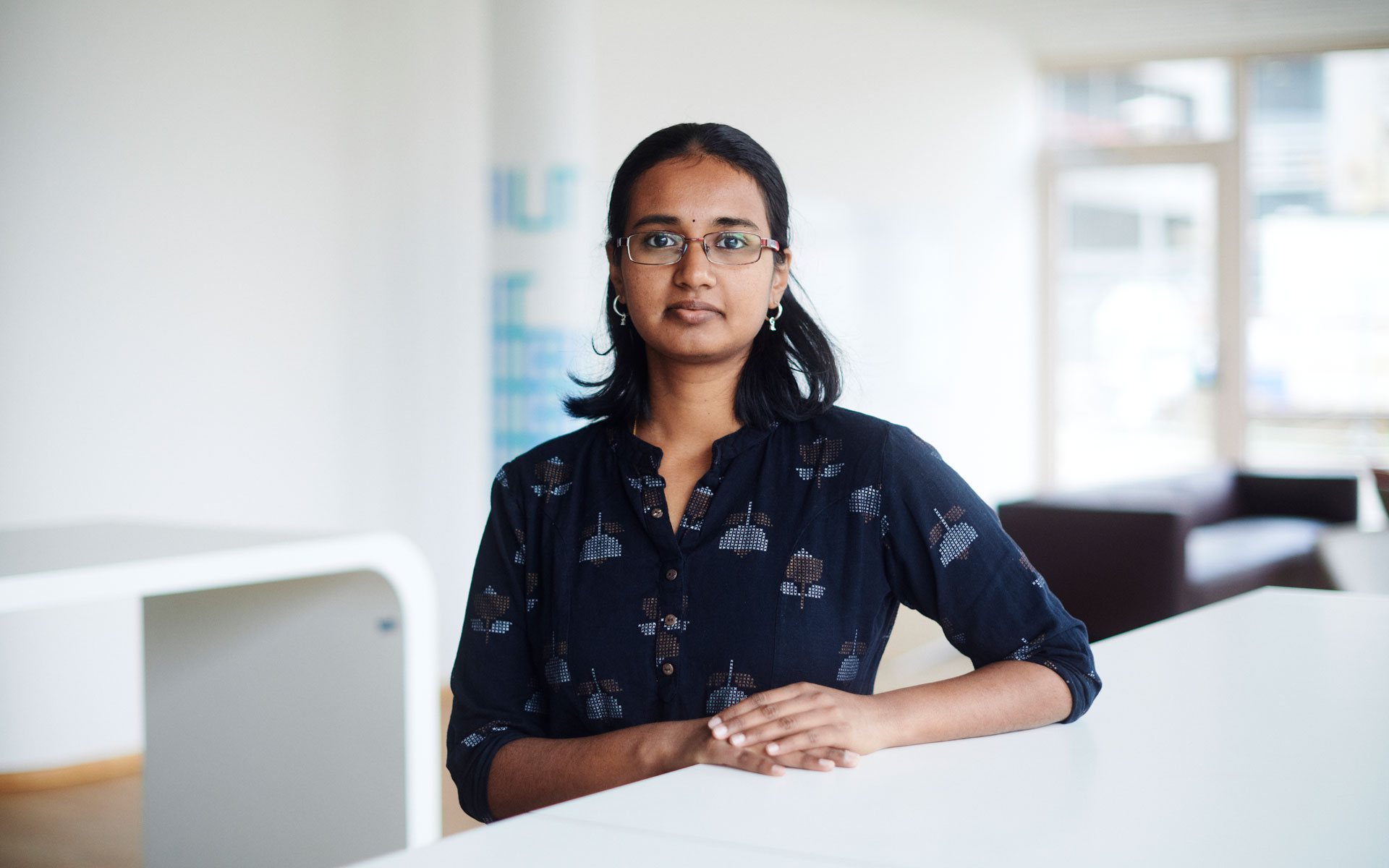
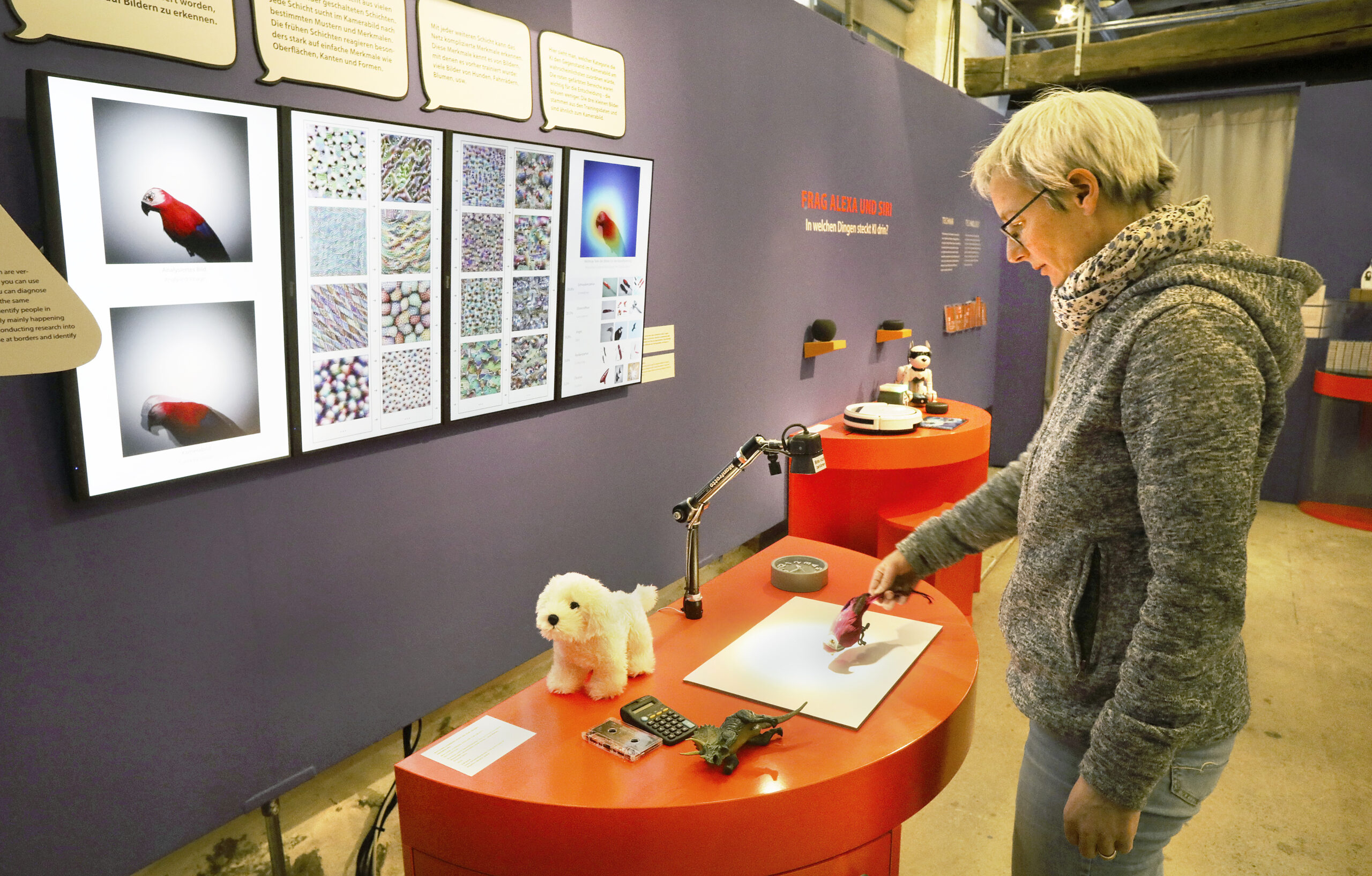

Comments